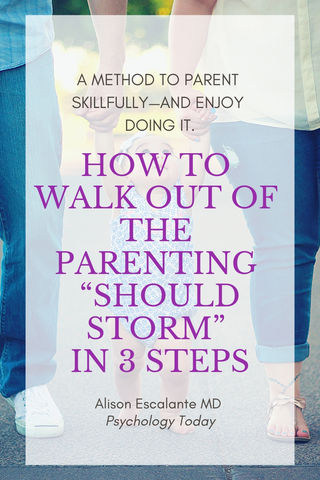Parenting
How to Walk out of the Parenting “Shouldstorm” in 3 Steps
A method to parent skillfully—and enjoy doing it.
Posted November 29, 2018
Have you ever been caught in the ShouldStorm?
My friends were. When I went to visit their new baby I saw what I had seen so many times before: anxious parents with shoulders up to their ears. The mom was clutching her baby protectively and had a thousand questions: “What should I do? It hurts to breast feed. Should I keep doing it? Should I use a nipple shield? Should I try soothies? Should I see the lactation consultant again? Should I try formula?”
I looked at her. “Wow! That’s quite a Shouldstorm right there.” There she was, with a miracle of life itself in her arms. But these two new parents were so filled with worry, they were not looking. They were distracted and disconnected. Have you ever felt this way?
The moment parenthood approaches, we are inducted into a culture of criticism that pushes perfectionistic parenting. We are told that everything matters so much and are warned of all that will go wrong if we mess up. It makes us anxious and overprotective, and it’s nearly impossible to escape.
(This post is adapted from my recent TEDx talk.)
Anxious parents raise anxious kids
The problem is that anxious parents raise anxious kids. Perfectionistic parents who alternate between demanding and over-nurturing, produce demanding kids who expect to be kept comfortable. The NIH reports that currently, 30 percent of our kids will meet criteria for an anxiety diagnosis by age 18.
In The Atlantic, Hanna Rosin highlighted how our “preoccupation with safety has stripped childhood of independence, risk taking, and discovery—without making it safer.” She pointed to studies showing that our way of constantly watching and protecting the kids actually leads them to grow up less creative and confident.
What should we do?
Okay, there’s a problem with anxiety. I bet we know just what to do next! We look things up. But wherever we turn, whether online, or books or neighbors, we keep hearing the same word: SHOULD.
Should tells us to listen because this person knows something we don’t. Should tells us that we need to do it this way, because that’s what is best for our kids. Or that’s what parents who really love their kids do. Or our kids will miss out on something important if we don’t do it this way.
We feel buffeted by the shoulds, like winds in a storm.
The ShouldStorm is tricky. The moment we engage with a should, we get pulled deeper into to the storm. We can’t fight the shoulds directly, they blow around us like wind. They are often good things, or even true. But they also contradict each other, and use threats.
Here are a few examples: You should get your kid up extra math tutoring, or they won’t get into the top math class. You should enroll your kid in travel sports, or they won’t be able to play in high school. You should make sure your child sleeps a minimum of 10 hours at night or their school performance will drop. Except, there's not enough time to do all of that.
The ShouldStorm is only three steps wide.
Every ShouldStorm feels unending and inescapable, it's only three steps wide. Do you remember what to do if you catch on fire? Stop, drop, and roll. What are the three steps out of the ShouldStorm? Sigh, See, and Start.
When you feel a SHOULD or you are NOT SURE.… SIGH. Take a deep breath, all the way into your belly. Imagine it’s a sigh of relief. Sighs help you stop and center yourself, instead of reacting to the should in your head.
SEE. See your child. See if they are happy. See if they are close to tears. See if their fists are balled in anger.
Then (and only then) START. Start listening, start thinking about what is appropriate here, start trying something different. Do they need a hug? Do they need some space? Do they need to figure it out for themselves?
It doesn’t matter what you start next. Start something, start nothing, start the wrong thing. It really doesn’t matter. Because if you SIGH, SEE, & START, you will build skills quickly. You will get to know your child. If you get it right, you’ve learned something. If you get it wrong, you may trigger a should, (Oh I should have done it that way), that’s okay, just go right into Sigh, See and Start again.
Simple does not mean easy.
This is simple advice, but that does not make it easy. How many times has your doctor told you to eat more vegetables or exercise for an hour a day? Simple actionable advice with a massive health impact. Are you doing it?
This advice is not specific, and we don’t like that. But this doesn’t mean you throw out your tool kit, this method helps you apply it wisely. So when you get to the Start step, you can pull what you want from those great books you’ve read and do it better. You will begin to have a better sense for when to hold those limits and when to collaborate with your kids.
Before I had only anxiety, but now I have confidence.
When I told my friends with the new baby about Sigh, See, & Start, they grinned. “We can try that,” they said, and their shoulders floated down. When I saw them again a month later, my friend said the most wonderful words I could imagine, “Thanks! I tried it and it worked. Before I had only anxiety, and now I have confidence."
©Alison Escalante MD

References
Merikangas KR, He JP, Burstein M, Swanson SA, Avenevoli S, Cui L, Benjet C, Georgiades K, Swendsen J. Lifetime prevalence of mental disorders in U.S. adolescents: results from the National Comorbidity Survey Replication--Adolescent Supplement (NCS-A). J Am Acad Child Adolesc Psychiatry. 2010 Oct;49(10):980-9. PMID: 20855043




